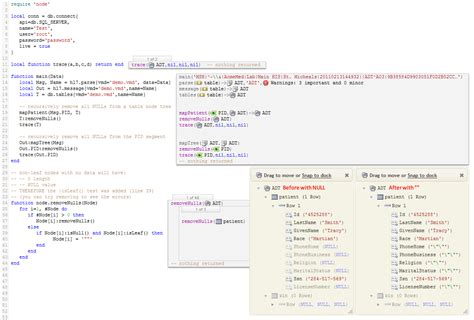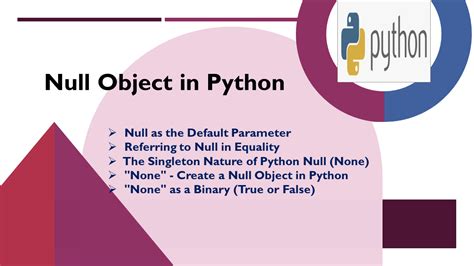Python is a versatile and widely used programming language that supports various data types, including numeric, string, and boolean. However, when it comes to representing the absence of a value, Python's behavior can be somewhat nuanced. In this article, we will delve into the concept of null values in Python, exploring how they are represented, created, and manipulated.
Introduction to Null Values in Python

In programming, a null value represents the absence of a value or a reference to no object. In Python, null values are represented by the None object, which is a singleton object that can be used to indicate the absence of a value. The None object is a fundamental part of the Python language and is used extensively in various contexts, including function returns, variable assignments, and data structures.
Creating and Assigning Null Values
To create a null value in Python, you can simply assign the None object to a variable. For example:
my_variable = None
This code assigns the `None` object to the `my_variable` variable, effectively creating a null value. You can also use the `None` object as a return value from a function or as a placeholder in a data structure.
| Operation | Example |
|---|---|
| Assigning None to a variable | my_variable = None |
| Returning None from a function | def my_function(): return None |
| Using None as a placeholder in a list | my_list = [1, 2, None, 4, 5] |

Checking for Null Values

To check if a variable or an object is null, you can use the is operator or the == operator. The is operator checks if both variables are referencing the same object, whereas the == operator checks for equality. For example:
my_variable = None
if my_variable is None:
print("my_variable is None")
if my_variable == None:
print("my_variable is equal to None")
Both of these conditions will evaluate to `True`, indicating that `my_variable` is indeed null.
Null Values in Data Structures
my_list = [1, 2, None, 4, 5]
This code creates a list with five elements, where the third element is null. You can access and manipulate null values in data structures just like any other value.
Key Points
- The `None` object represents null values in Python.
Best Practices for Working with Null Values
When working with null values in Python, it’s essential to follow best practices to avoid common pitfalls and ensure that your code is robust and maintainable. Here are some guidelines to keep in mind:
- Always check for null values before attempting to access or manipulate them.
- Use the
isoperator to check if a variable is referencing theNoneobject. - Avoid using the
==operator to check for null values, as it can lead to unexpected behavior. - Use null values judiciously, as they can make your code more complex and harder to understand.
Common Pitfalls and Errors
When working with null values, it’s easy to encounter common pitfalls and errors. Here are some examples:
- Attempting to access or manipulate a null value without checking for its existence.
- Using the
==operator to check for null values, which can lead to unexpected behavior. - Failing to handle null values in data structures, which can cause errors or crashes.
What is the difference between `None` and `null` in Python?
+In Python, `None` is the singleton object that represents null values, whereas `null` is not a valid keyword or object in Python.
How do I check if a variable is null in Python?
+You can use the `is` operator to check if a variable is referencing the `None` object, like this: `if my_variable is None:`.
Can I use null values in data structures like lists and dictionaries?
+Yes, you can use null values in data structures like lists and dictionaries. For example, you can create a list with null values like this: `my_list = [1, 2, None, 4, 5]`.
In conclusion, null values are an essential part of the Python language, and understanding how to work with them is crucial for writing robust and maintainable code. By following best practices and avoiding common pitfalls, you can effectively use null values in your Python programs and ensure that your code is reliable and efficient.
Meta Description: Learn about null values in Python, including how to create, assign, and check for them, as well as best practices for working with null values in data structures.



